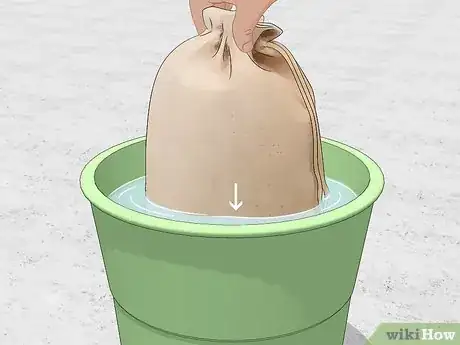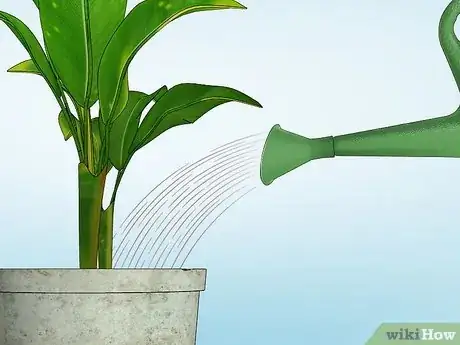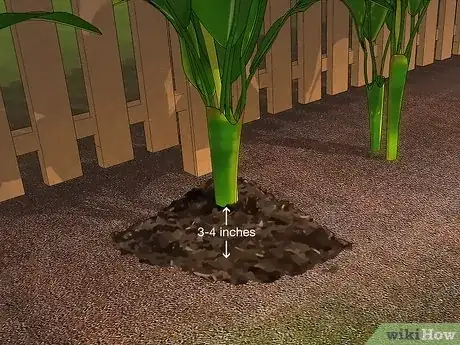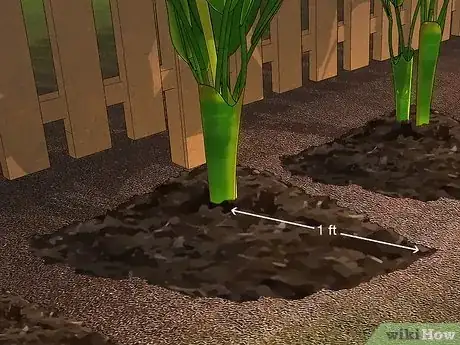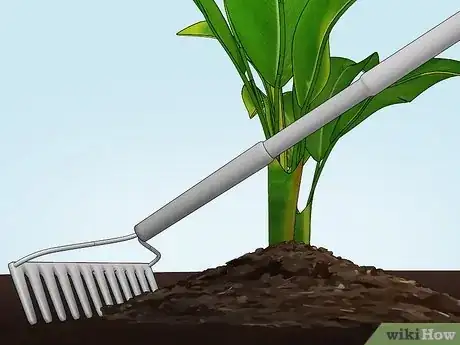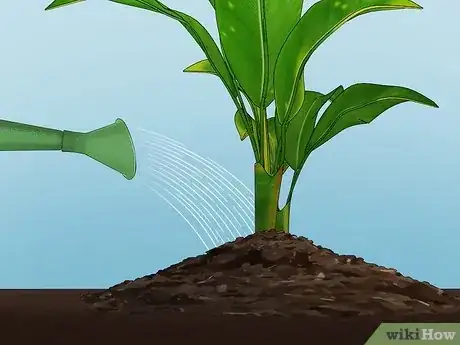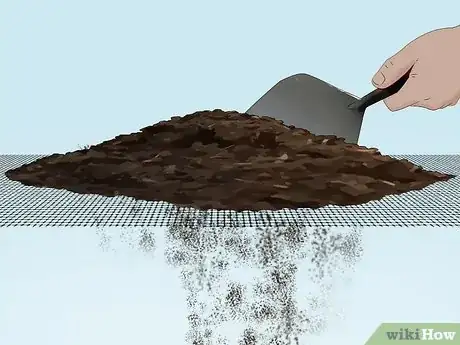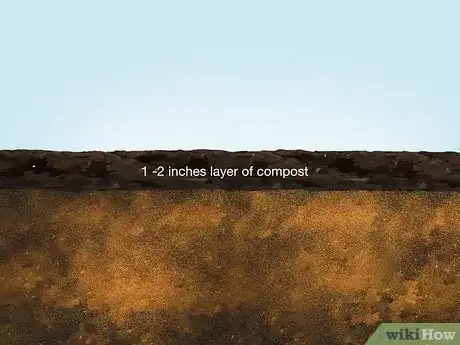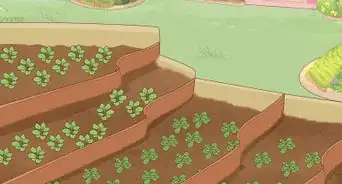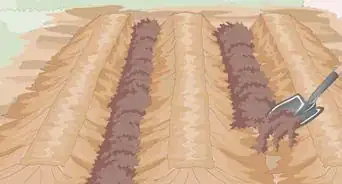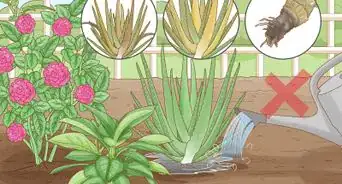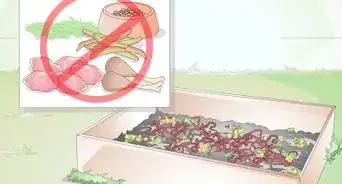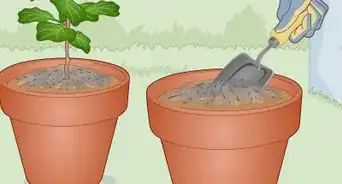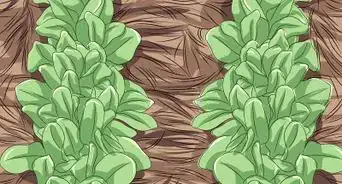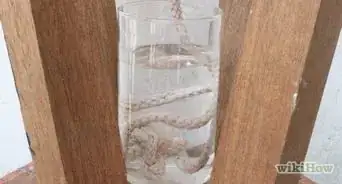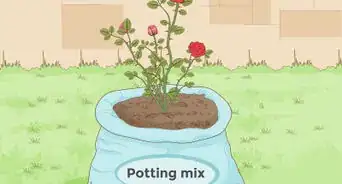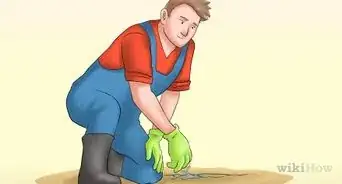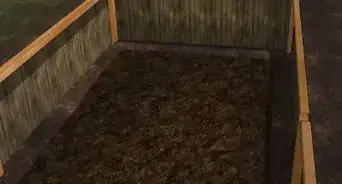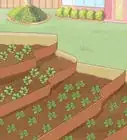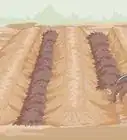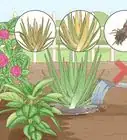This article was co-authored by Lauren Kurtz and by wikiHow staff writer, Sophia Latorre. Lauren Kurtz is a Naturalist and Horticultural Specialist. Lauren has worked for Aurora, Colorado managing the Water-Wise Garden at Aurora Municipal Center for the Water Conservation Department. She earned a BA in Environmental and Sustainability Studies from Western Michigan University in 2014.
wikiHow marks an article as reader-approved once it receives enough positive feedback. In this case, several readers have written to tell us that this article was helpful to them, earning it our reader-approved status.
This article has been viewed 80,510 times.
Adding compost to plants provides them with nutrients that help them thrive and flourish! Compost is decomposed organic matter, such as leaves and food scraps. Adding compost to soil improves its texture and health by allowing more air space in between the particulates, creating better drainage. It also attracts earthworms, which create a healthy environment for your flowers and vegetables. You can add compost to your plants in several ways, including watering them with compost tea, amending your soil with compost, digging compost holes, and using compost as mulch. All of these methods will improve the quality of your garden soil.
Steps
Choosing or Making Compost
-
1Start composting at home. Create a compost heap by layering soil with organic materials. Alternate brown materials (like dried leaves, straw, sawdust, and shredded paper) with green materials (like fresh leaves, coffee grounds, and fruit and vegetable scraps). Don’t add anything with meat, oil, fat, or dairy to your compost. Regularly water the heap until it is damp but not soggy.[1]
-
2Select organic, high-quality compost. If you don’t have the time, space, or materials to make your own compost, you can purchase it. However, you need to choose carefully as some compost contains human sewage, pharmaceuticals, and solvents. Look for organic, high-quality compost that contains leaf mold, yard waste, and animal manure.[2]
- Feel the bag as well, it should be light, fluffy, and have an earthy smell. Avoid purchasing compost that is heavy, feels sandy, or smells of ammonia.
- Visit your local garden shop to pick out compost so that you can smell and feel it before making a purchase.
Advertisement -
3Ensure your compost has decomposed thoroughly before using it. Compost is ready when it is dark brown, crumbly, and has an earthy smell. It should not be moldy, powdery, hot, or smell like ammonia. If you can still discern what some of the elements of the compost are (e.g., a banana peel), the compost needs more time to decompose before you use it in your garden.[3]
Making Compost Tea
-
1Fill a burlap bag with compost. If you don’t have a burlap bag, you can use an old pillowcase. Fill the bag or case with compost, then close up the open end.
-
2Submerge the compost bag in a tub of water. Fill a tub, bin, or bucket with water, then place your compost bag inside of it. Shake the bag around for a few minutes to help the water penetrate the bag and compost.
-
3Allow the bag to steep for a few days. In order to allow the nutrients to leach from the compost and into the water, allow the bag to steep for two to three days. You’ll be able to tell it is ready when the water is the color of tea.
-
4Spray or pour the compost tea on your plants. Fill a spray bottle or watering can with the compost tea. Pour or spray the water on and around your potted or garden plants to give them a drink full of nutrients.
- You can use the bag of compost to make a few batches of compost tea, then spread the wet compost around your garden.
Amending Your Soil with Compost
-
1Spread 3 to 4 inches (7.6 to 10.2 cm) of compost on top of your soil. Amending your garden soil will help your plants flourish. Add 3 to 4 inches (7.6 to 10.2 cm) of compost to the soil around the plants in your garden. Stay several inches away from the bases of existing plants.
-
2Leave the compost undisturbed near your plants. You don’t want to disturb the roots of plants that are already growing in your garden. Rather than raking and tilling the compost into the soil around your plants, leave the compost as is in a 1 foot (30 cm) radius around the base of your plants.[4]
-
3Rake and till the compost layer into the existing soil around your plants. In order to mix the compost into your existing soil, rake and till the compost into the upper 6 inches (15 cm) of the soil around your plants. This provides aeration and allows the nutrients in the compost to enrich your existing soil.
-
4Water your garden. Lightly water your garden until the soil is moist. This helps the nutrients leach from the compost into the deeper layers of the soil, which will feed your plants.[5]
Digging Compost Holes
-
1Dig holes 12 inches (30 cm) deep in your garden. Use a spade or shovel to dig several holes that are 12 inches (30 cm) deep between your garden rows. Dig as many holes as you can fill in with the compost you have on hand.[6]
-
2Put 2 quarts (1.9 L) of compost in each hole. Pour or shovel 2 US quarts (2,000 ml) (1.9 L) of compost into each hole. You don’t want to fill the entire hole with compost, as you’ll add some of the existing garden soil to the hole as well.[7]
-
3Fill in the rest of the hole with soil. Using the soil you removed from the hole, cover the compost with soil until it is level with the rest of your garden bed. The nutrients from the compost will enrich the soil in your garden and help your plants thrive.[8]
Using Compost as Mulch
-
1Clear weeds and grass away from the area. To ensure that nothing grows through your new layer of mulch, clear away weeds and grass from the area you will add mulch to. Be sure to remove the weed roots from the ground so they don’t grow back.
-
2Screen the compost. Sift the compost through a screen to remove large pieces. You can use an old screen or make your own by attaching 0.5 in (1.3 cm) mesh hardware cloth to a wooden frame. Place your screen over a wheelbarrow and sift the compost into it. Reserve the large pieces for your next compost pile.
-
3Cover your garden plot with the compost. Spread 1 to 2 inches (2.5 to 5.1 cm) of compost over the top layer of soil in your garden. Make sure to spread the mulch evenly throughout the area, working around existing plants. Keep the compost layer about 2 inches (5.1 cm) away from the base of existing plants and their stems.
Expert Q&A
-
QuestionHow should I fertilize my plants?
 Lauren KurtzLauren Kurtz is a Naturalist and Horticultural Specialist. Lauren has worked for Aurora, Colorado managing the Water-Wise Garden at Aurora Municipal Center for the Water Conservation Department. She earned a BA in Environmental and Sustainability Studies from Western Michigan University in 2014.
Lauren KurtzLauren Kurtz is a Naturalist and Horticultural Specialist. Lauren has worked for Aurora, Colorado managing the Water-Wise Garden at Aurora Municipal Center for the Water Conservation Department. She earned a BA in Environmental and Sustainability Studies from Western Michigan University in 2014.
Professional Gardener Many plants need regular fertilizing to thrive. Find out what plants you have so that you can learn about their specific fertilizer needs. Or, try fertilizing with a balanced fertilizer monthly that's 5% nitrogen, 5% phosphorous and 5% potassium.
Many plants need regular fertilizing to thrive. Find out what plants you have so that you can learn about their specific fertilizer needs. Or, try fertilizing with a balanced fertilizer monthly that's 5% nitrogen, 5% phosphorous and 5% potassium. -
QuestionCan I put vegetable compost on my flower beds?
 Lauren KurtzLauren Kurtz is a Naturalist and Horticultural Specialist. Lauren has worked for Aurora, Colorado managing the Water-Wise Garden at Aurora Municipal Center for the Water Conservation Department. She earned a BA in Environmental and Sustainability Studies from Western Michigan University in 2014.
Lauren KurtzLauren Kurtz is a Naturalist and Horticultural Specialist. Lauren has worked for Aurora, Colorado managing the Water-Wise Garden at Aurora Municipal Center for the Water Conservation Department. She earned a BA in Environmental and Sustainability Studies from Western Michigan University in 2014.
Professional Gardener Yes, flower beds will benefit from compost, even if the compost is recommended for vegetables.
Yes, flower beds will benefit from compost, even if the compost is recommended for vegetables.
References
- ↑ http://www.bhg.com/gardening/yard/compost/how-to-compost/
- ↑ https://www.rodalesorganiclife.com/garden/buying-compost
- ↑ http://www.bhg.com/gardening/yard/compost/how-to-compost/
- ↑ http://www.bhg.com/gardening/yard/compost/how-can-i-add-compost-to-an-established-garden/
- ↑ http://www.bhg.com/gardening/yard/compost/how-can-i-add-compost-to-an-established-garden/
- ↑ https://dengarden.com/gardening/Compost-Holes-A-Cheap-Easy-Way-to-Enrich-Your-Soil
- ↑ https://dengarden.com/gardening/Compost-Holes-A-Cheap-Easy-Way-to-Enrich-Your-Soil
- ↑ https://dengarden.com/gardening/Compost-Holes-A-Cheap-Easy-Way-to-Enrich-Your-Soil




